AUDI Q3 2017 Owner´s Manual
Manufacturer: AUDI, Model Year: 2017, Model line: Q3, Model: AUDI Q3 2017Pages: 236, PDF Size: 58.93 MB
Page 141 of 236
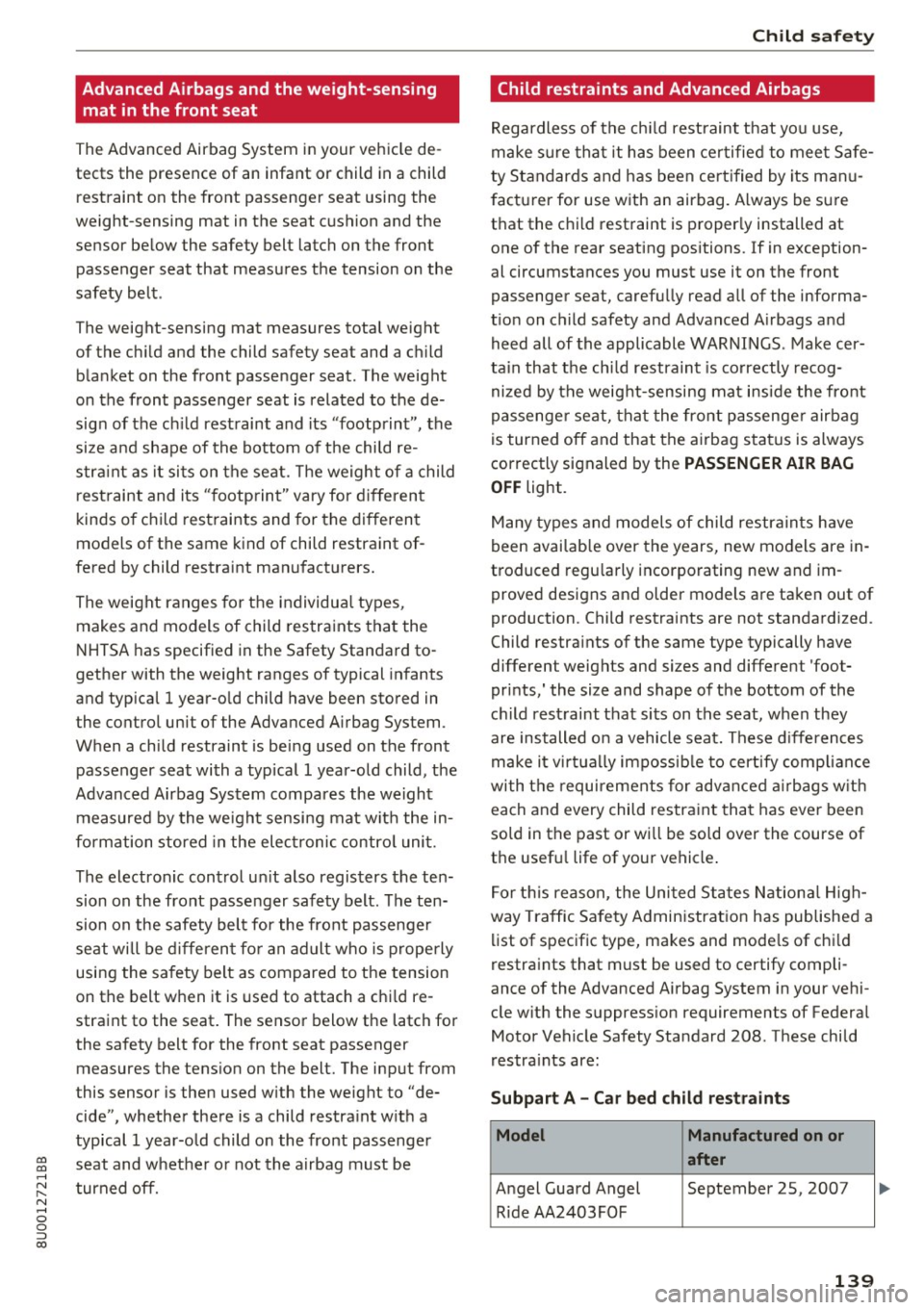
00
00
......
"' ,....
"' ...... 0 0 :::,
00
Advanced Airbags and the weight-sensing
mat in the front seat
The Advanced Airbag System in your vehicle de
tects the presence of an infant or child in a child
restraint on the front passenger seat using the
weight-sensing mat in the seat cushion and the
sensor below the safety belt latch on the front passenger seat that measures the tension on the
safety belt .
The weight-sensing mat measures total weight
of the child and the child safety seat and a child blanket on the front passenger seat. The weight
on the front passenger seat is related to the de
sign of the chi ld restraint and its "footprint", the
size and shape of the bottom of the chi ld re
stra int as it sits on the seat. The weight of a child
restraint and its "footp rint" vary for different
kinds o f child restraints and for the different
models of the same kind of child restraint of
fered by child restraint manufacturers.
The weight ranges for the individual types,
makes and models of child restraints that the
NHTSA has specified in the Safety Standard to
gether with the weight ranges of typical infants
and typical 1 year-old child have been stored in
the control unit of the Advanced Airbag System .
When a child restraint is be ing used on the front
passenger seat with a typical 1 year-old child, the
Advanced Airbag System compares the weight measured by the weight sensing mat with the in
formation stored in the electronic contro l unit.
The electronic control un it also registers the ten
sion on the front passenger safety belt . The ten
sion on the safety belt for the front passenger
seat will be d ifferent fo r an ad ult who is properly
using the safety belt as compared to the tension
on the belt when it is used to attach a chi ld re
straint to the seat. The sensor below the latch for
the safety belt for the front seat passenger measures the tens ion on the belt. The input from
this sensor is then used with the weight to "de
cide", whether there is a child restraint w ith a
typical 1 year-old child on the front passenger
seat and whet her o r not the a irbag must be
turned off.
Ch ild safety
Child restraints and Advanced Airbags
Regardless of the ch ild restraint that you use,
make s ure tha t it has been cer tified to mee t Safe
ty Standards and has been cert ified by its manu
facturer for use with an airbag. Always be sure
that the c hild restraint is properly installed at
one of the rear seating positions. If in exception
al circumstances you must use it on the front
passenger seat, carefully read all of the informa
t ion on child safety and Advanced A irbags and
heed all of the applicable WARNINGS . Make cer
ta in that the ch ild restraint is correctly recog
nized by the weight-sensing mat ins ide the front
passenge r seat, that the front passenge r airbag
is turned off and that the airbag status is always
correctly signaled by the
PASSENGER AIR BAG
OFF
light .
Many types and models of child restra ints have
been avai lab le over the years, new models are in
t roduced regu larly incorporating new and im
proved designs and older models are taken out of
production. Child restraints are not standardized.
Child restra ints of the same type typically have
different weights and sizes and different 'foot
pr ints,' the size and shape of the bottom of the
ch ild rest raint that sits on the seat, when they
are installed on a vehicle seat. These d ifferences
make it virt ua lly impossib le to certify comp liance
wi th the requi rements for advanced a irbags w it h
each and every child restraint tha t has ever been
sold in the past or wi ll be so ld over the course of
the usefu l life of your vehicle .
For t his reason, the Uni ted States N ation al High
way Traffic Sa fety Administration has published a
list of specific type, makes and mode ls of chi ld
restraints that must be used to certify compli
ance of the Advanced Airbag System in your vehi
cle w ith the suppress ion requirements of Federal
Motor Vehicle Safety Standard 208 . These child
restra ints are:
Subpart A - C ar b ed child r estra int s
Model Manufactured on or
after
Angel Guard Angel September 2S, 2007 R ide AA2403FOF
139
Page 142 of 236
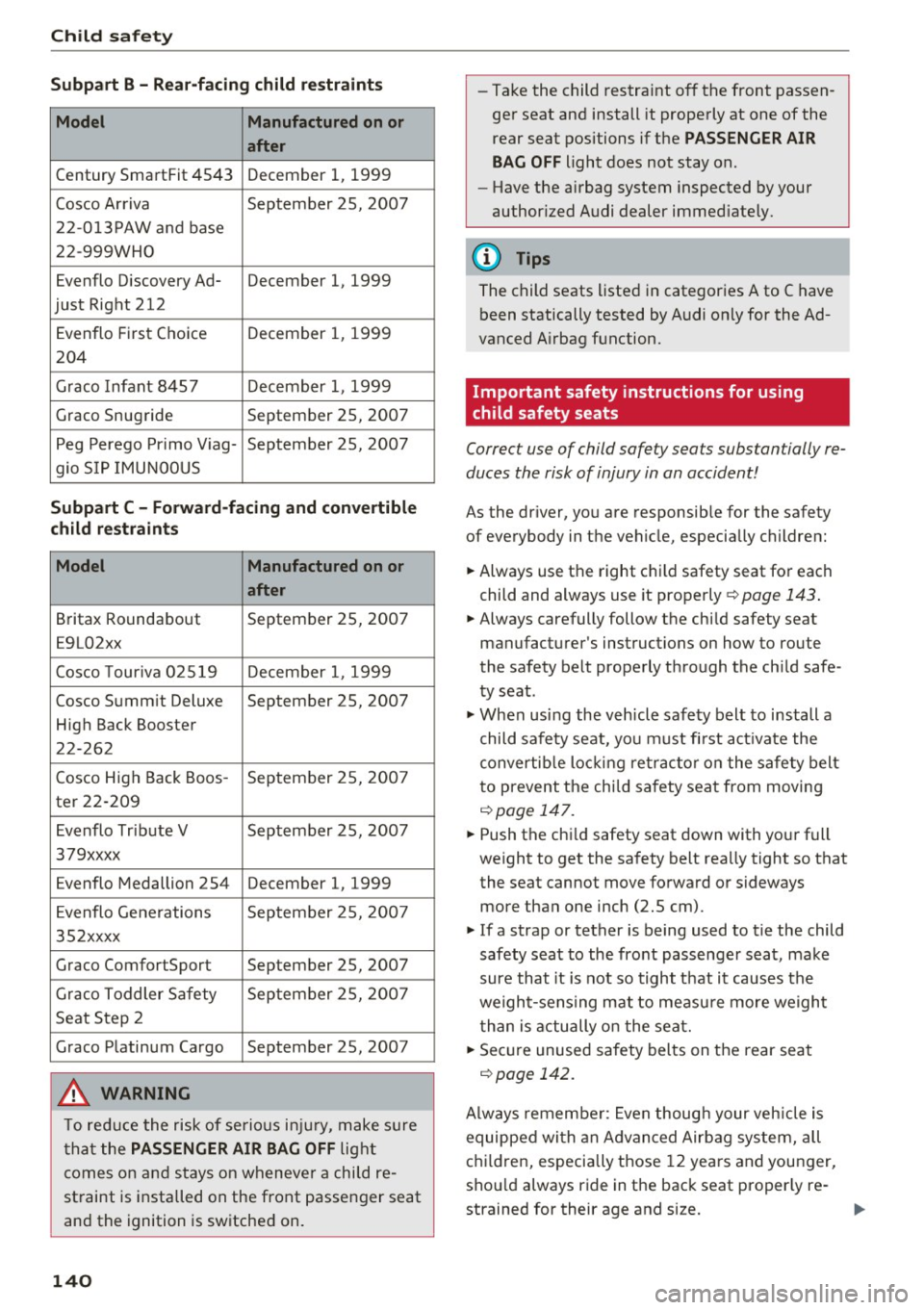
Child safety
Subpart B - Rear-facing child restraints
Model Manufactured on or
after
Century SmartFit 4543 December 1, 1999
Cosco Arriva September 25, 2007
22-013PAW and base
22-999WHO
Evenflo Discovery Ad- December 1, 1999
just Right 212
Evenflo First Cho ice December 1, 1999
204
G raco Infant 8457 December 1 , 1999
Graco Snug ride September 25, 2007
Peg Perego Primo Viag- September 25, 2007
gio SIP IMUNOOUS
Subpart C -Forward -facing and convertible
child restraints
Model Manufactured on or
after
Britax Roundabout September 25, 2007
E9L02xx
Cosco Tour iva 02519 December 1, 1999
Cosco Summit Deluxe September 25, 2007
High Back Booster
22-262
Cosco High Back Boos-
September 2S, 2007
ter 22-209
Evenflo Tribute V September 25, 2007
379xxxx
Evenflo Medallion 254 December 1, 1999
Evenflo Generations September 25, 2007
352xxxx
Graco ComfortSport September 25, 2007
Graco Toddler Safety September 25, 2007
Seat Step 2
Graco Platinum Cargo September 25, 2007
.,&. WARNING
To reduce the risk of serious i njury, make sure
t ha t the
PASSENGER AIR BAG OFF light
com es on and stays on whenever a child re
straint is installed on the front passenger seat
and the ignition is switched on.
140
-Take the child restraint off the front passen
ger seat and install it properly at one of the
rear seat positions if the
PASSENGER AIR
BAG OFF
light does not stay on .
- Have the airbag system inspected by your
authorized Audi dealer immed iately.
@ Tips
The child seats listed in categor ies A to C have
been statically tested by Audi only for the Ad
vanced Airbag function.
' Important safety instructions for using
child safety seats
Correct use of child safety seats substantially re
duces the risk of injury in an accident!
As the dr iver, you are responsible for the safety
of everybody in the vehicle, especially children:
.. Always use the right child safety seat for each
child and always use it properly ¢
page 143 .
.. Always carefully follow the child safety seat
manufacturer's instructions on how to route
the safety belt properly through the child safe
ty seat.
.. When using the vehicle safety belt to install a
child safety seat, you must first activate the
convertible locking retractor o n the safety belt
to prevent t he child safety seat from moving
c::>page 147.
.. Push the chi ld safety seat down with your full
weight to get the safety belt really tight so that
the seat cannot move forward or sideways
more than one inch (2.5 cm) .
.. If a strap or tether is being used to tie the child
safety seat to the front passenger seat , make
sure that it is not so tight that it causes the
we ight-sensing mat to measure more weight
than is actually on the seat.
.. Secure unused safety belts on the rear seat
c::> page 142 .
Always remembe r: Even though your vehicle is
equipped with an Advanced Airbag system, all
children, especially those 12 years and younger,
shou ld always ride in the back seat properly re-
strained for their age and size. .,._
Page 143 of 236
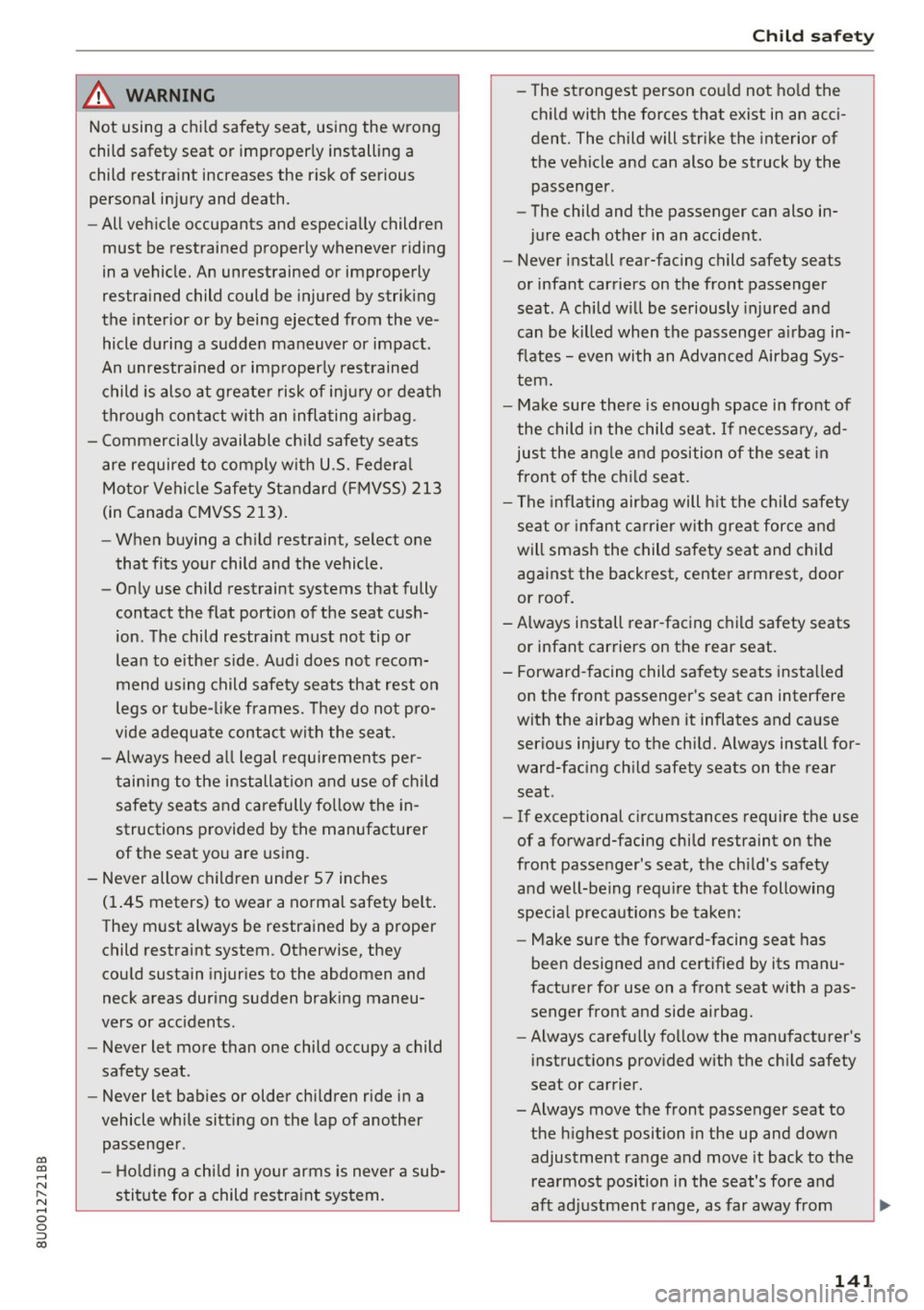
00
00
......
"' ,....
"' ...... 0 0 :::,
00
& WARNING
Not using a c hild safety sea t, using the wrong
child safety seat or improperly installing a
child restraint increases the r isk of serious
personal injury and death.
- All vehi cle occupants and especially children
must be restrained properly whenever riding
in a vehicle. An unrestrained or improperly
restrained child could be injured by striking
the interior or by being ejected from the ve
hicle during a sudden maneuver or impact.
An unrestrained or imp roperly restrained
child is also at greater risk of inju ry or death
through contact with an inflating airbag .
- Commercially available ch ild safety seats
are required to comply with U.S. Federa l
Motor Vehicle Safety Standard (FMVSS) 213
(in Canada CMVSS 213).
- When buying a ch ild restraint, select one
that fits your child and the vehicle .
- Only use child restraint systems that fully
contact the flat portion of the seat cush
ion . The child restraint must not tip or
lean to either s ide . Audi does not recom
mend using child safety seats that rest on
legs or tube- like frames. They do not pro
vide adequa te contact with the sea t.
- Always heed a ll legal requ irements pe r
taining to the installation and use of child
safety seats and carefully fo llow the in
structions provided by the manufacturer
of the seat you are using.
- Never allow ch ildren under 57 inches
(1.45 meters) to wear a normal safety belt .
They must always be restrained by a proper child restraint system. Otherwise, they
cou ld sustain injur ies to the abdomen and
neck areas during sudden braking maneu
vers or acc idents.
- Never let more than one child occupy a child
safety seat .
- Never let babies or older chi ldren ride in a
vehicle while sitting on the lap of another passenger .
- Ho ld ing a chi ld in your arms is never a sub
stit ute for a child restra int system.
Ch ild safety
-The strongest person cou ld not ho ld the
ch ild with the forces that exist in an acci
dent. The child will strike the interior of
the vehicle and can also be struck by the
passenger.
- The child and the passenger can also in
jure each other in an accident.
- Never install rear-facing child safety seats
or infant carriers on the front passenger
seat . A child w ill be seriously injured and
can be killed when the passenger a irbag in
flates - even with an Advanced Airbag Sys
tem.
- Make sure the re is e nough space in front of
the child in the child seat. If ne cessary, ad
just the angle and position of the se at in
front of the ch ild seat.
- The inflating airbag will h it the c hild safety
seat o r infant carr ier with great force and
will smash the child safety seat and child
against the backrest, center armrest, door
or roof .
-Always install rear -facing child safety seats
or infant carriers on the rear seat.
- Forward -facing child safety seats insta lled
on the front passenger's seat can interfere
with the airbag when it inflates and cause serio us injury to the chi ld. Always install for
ward-facing ch ild safety seats on the rear
seat .
- If exceptional c ircumstances requ ire the use
of a forward-facing child restraint on the
front passenger's seat, the ch ild's safety
and well-being requ ire that the following
specia l precautions be ta ken:
- Make sure the forward -facing seat has
been designed and certified by its manu
facturer for use on a front seat with a pas
senger front and side airbag.
- Always carefully follow the man ufacturer's
instruct ions prov ided with the ch ild safety
seat or carrier.
- Always move the front passenger seat to
the h ighest position in the up and down
adjustment range and move it back to the
rearmost position in the seat's fore and
aft ad justmen t range, as far away from
141
Page 144 of 236
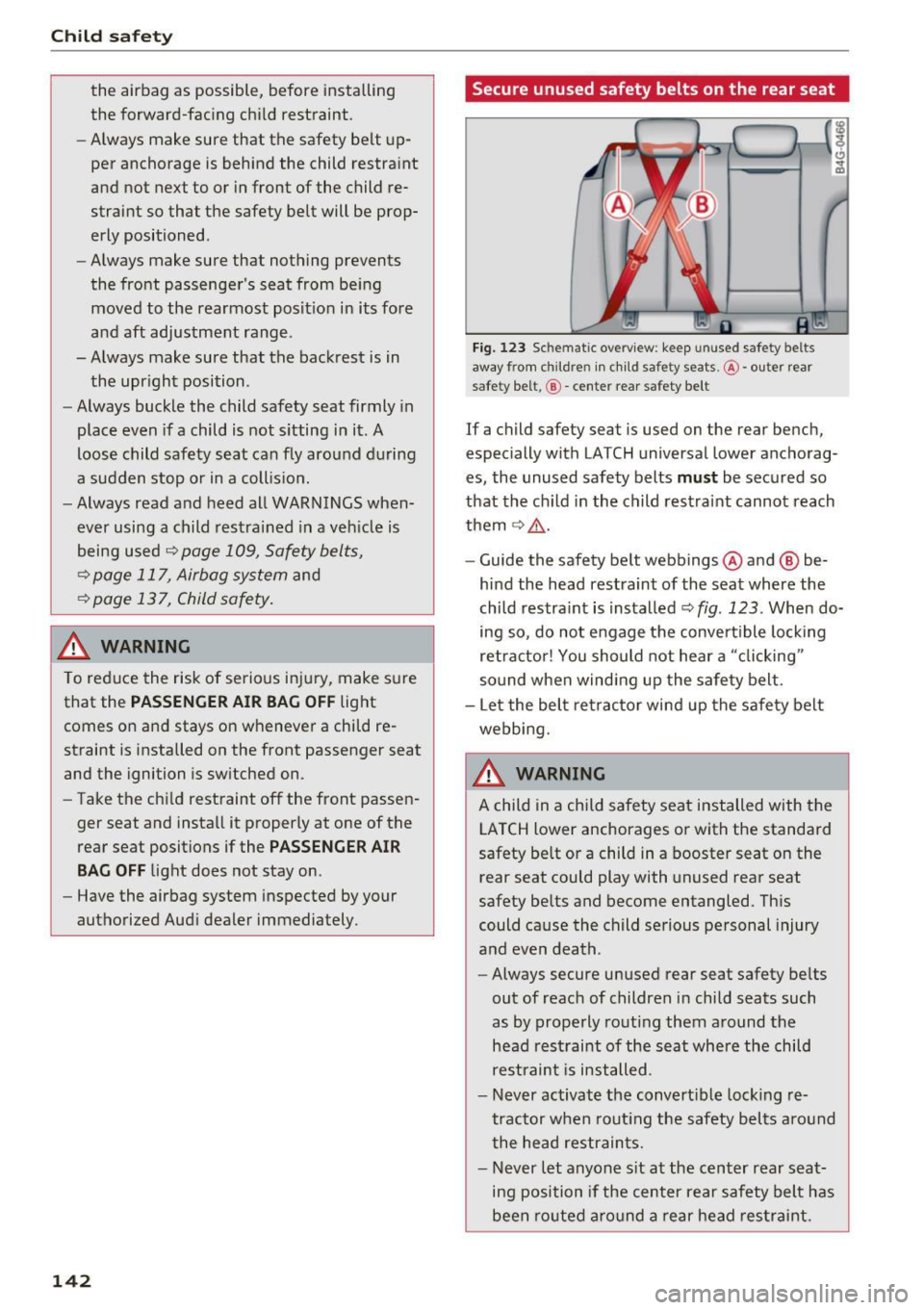
Child safety
the airbag as possible, before installing
the forward-facing child restraint.
- Always make sure that the safety be lt up
per anchorage is behind the child restra int
and not next to or in front of the child re
straint so that the safety belt will be prop
erly positioned.
- Always make sure that nothing prevents
the front passenger's seat from be ing
moved to the rearmost pos it ion in its fore
and aft adjustment range.
- Always make sure that the backrest is in the upr ight position .
- Always buckle the child safety seat firmly in
place even if a child is not s itting in it. A
loose child safety seat can fly around during
a sudden stop or in a collis ion.
- Always read and heed all WARNINGS when
ever using a child restrained in a veh icle is
being used
r:!;> page 109, Safety belts,
r:!;> page 117 , Airbag system and
r:!;> page 13 7, Child safety .
,8. WARNING
To reduce the risk of se rious injury, make s ure
that the
PASSENGER AIR BAG OFF light
comes on and stays on whenever a child re
straint is installed on the front passenger seat
and the ignition is sw itched on.
- Take the ch ild restraint off the front passen
ger seat and install it properly at one of the
rear seat positions if the
PASSENGER AIR
BA G OF F
light does not stay on.
- Have the airbag system inspected by your
authorized Audi dealer immediately.
142
Secure unused safety belts on the rear seat
Fig. 123 Schematic overview: keep unused safety belts
away from children in ch ild safety seats. @· ou ter rear
safety belt,® -center rear safety belt
If a child safety seat is used on the rear bench,
especially with LATCH universal lower anchorag
es, the unused safety belts
mu st be secured so
that the ch ild in the child restraint cannot reach
them
r:!;> .& -
-Guide the safety belt webbings @and @ be·
hind the head restraint of the seat where the
child restra int is installed
~fig . 123. When do·
ing so, do no t engage the convert ible locking
retractor! You should not hear a "cl icking"
sound when winding up the safety belt.
- Let the belt re trac to r wind up the safe ty belt
webbing.
~ WARNING
-A child in a child safety seat installed with the
LATCH lower anchorages or with the standard
safety be lt or a child in a booster seat on the
rear seat could play with unused rear seat
safety belts and become entangled. This
could cause the child serious personal injury
and even death.
- Always secure unused rear seat safety belts
out of reach of children in child seats such
as by properly ro uting them around the
head restraint of the seat where the child
restraint is installed.
- Never activate the convert ible lock ing re·
tractor when rout ing the safety belts aro und
the head restrain ts.
- Never let anyone s it at the center rear seat
ing position if the center rear safety belt has
been routed around a rear head restraint.
Page 145 of 236
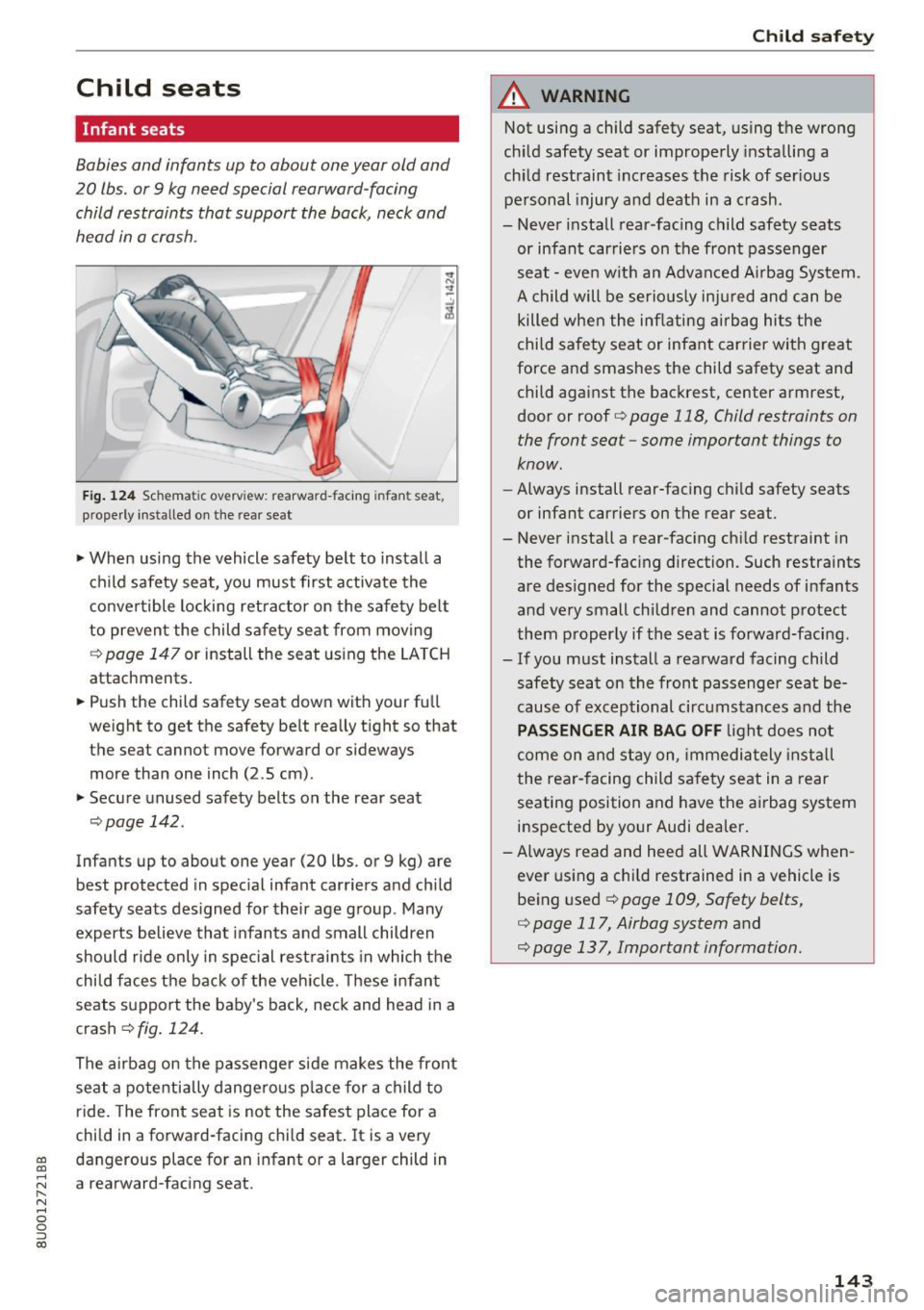
Child seats
Infant seats
Babies and infants up to about one year old and
20 lbs. or 9 kg need special rearward -facing
child restraints that support the back, neck and
head in a crash .
Fig. 124 Schemat ic overview: rearward-facing infant seat,
properly installed on the rear seat
"'When using the vehicle safety belt to install a
child safety seat, you must first activate the
convertible locking retractor on the safety be lt
to prevent the child safety seat from moving
¢ page 147 or install the seat using the LA TC H
attachments.
"' Push the child safety seat down with your full
weight to get the safety belt really tight so that
the seat cannot
move forward or sideways
more than one inch (2.5 cm).
"'Secure unused safety belts on the rear seat
¢page 142.
Infants up to about one year (20 lbs. or 9 kg) are
best protected in special infant carriers and child
safety seats des igned for their age group . Many
experts believe that infants and small children
should ride only in spec ial restraints in which the
chi ld faces the back of the vehicle. These infant
seats support the baby 's back, neck and head in a
crash
c!;> fig . 124.
The airbag on the passenger side makes the front
seat a potentially dangero us p lace for a child to
ride. The front seat is not the safest place for a
chi ld in a forward-facing child seat. It is a very
a:1 dangerous place for an infant or a larger child in a:,
~ a rearward-facing seat. r--. N
'"' 0 0 ::, a:,
Child sa fety
A WARNING
-Not using a child safety seat, using the wrong
ch ild safety seat or improperly installing a
child restraint increases the risk of ser ious
personal injury and death in a crash .
- Never install rear-facing child safety seats
or infant carriers on the front passenger
seat -even w ith an Advanced A irbag System .
A child will be serio usly inj ured and can be
killed when the inf lating airbag hits the
chi ld safety seat or infant carrier with great
force and smashes the child safety seat and
child against the backrest, center armrest,
door or roof
c!;> page 118, Child restraints on
the front seat -some important things to
know.
- Always install rear-fac ing child safety seats
or infant carriers on the rear seat.
- Never install a rear-facing child restraint in
the forward-facing direction . Such restraints
are designed for the special needs of infants
and very small children and cannot protect
them p roperly if the seat is forward-faci ng.
- If you must install a rearward facing child
safety seat on the front passenger seat be
cause of exceptional circumstances a nd the
PASSENGER AIR BAG OFF li ght does not
come on and stay on, immediately install
the rea r-facing child sa fety seat in a rear
seating position and have the a irbag system
inspected by your Audi dealer .
-A lways read and heed all WARNINGS when
ever using a child restrained in a vehicle is
be ing used
c!;> page 109, Safety belts,
c:> page 117 , Airbag system and
c:> page 137, Important information.
143
Page 146 of 236
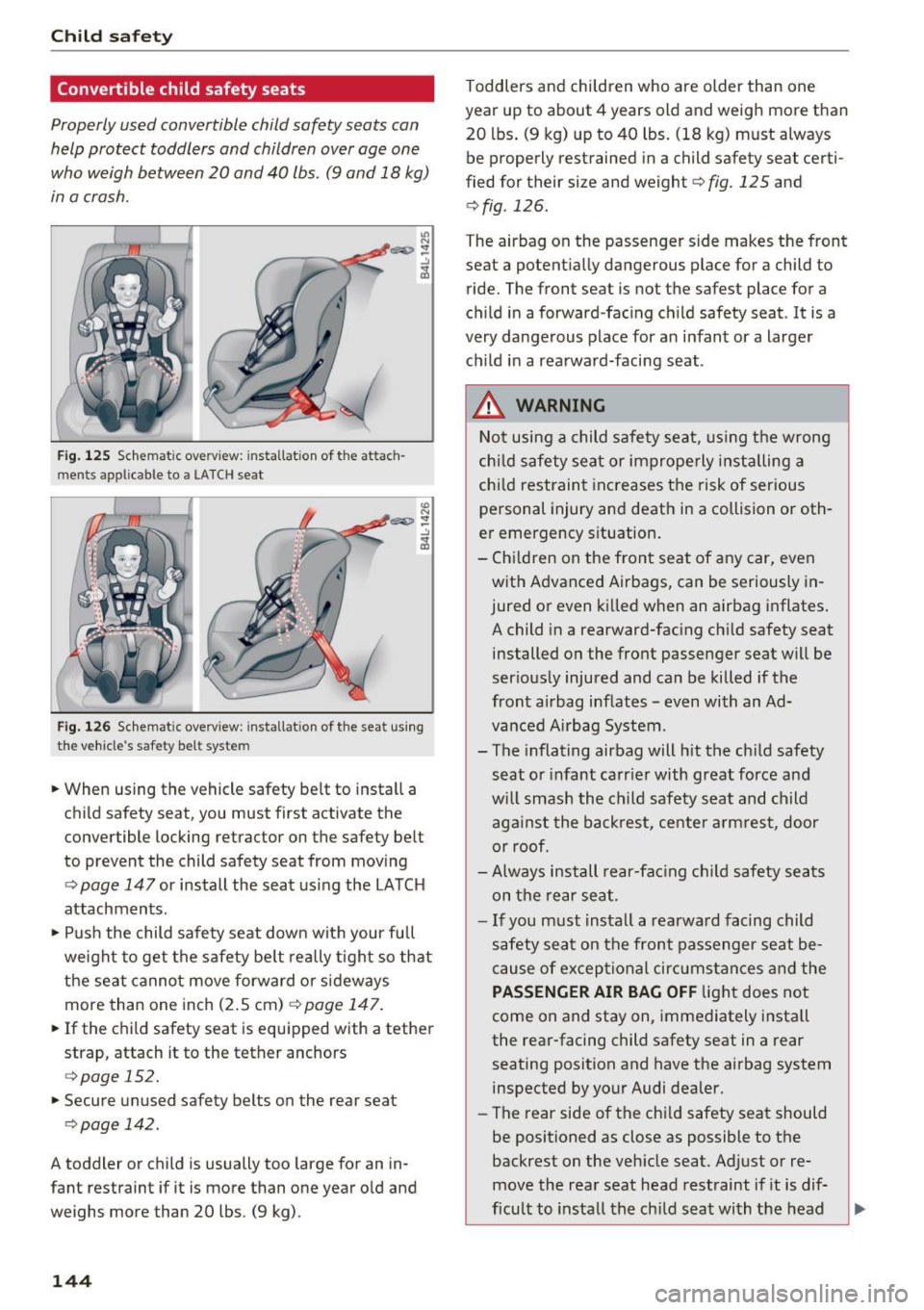
Child safety
Convertible child safety seats
Properly used convertible child safety seats can
help protect toddlers and children over age one
who weigh between 20 and 40 lbs. (9 and 18 kg)
in a crash.
Fig. 125 Schematic overv iew: installat ion of the attach
ments app licable to a LATCH seat
Fig. 126 Schemat ic overview: installat ion of the seat using
the vehicle 's safety belt system
.. When using the vehicle safety be lt to install a
child safety seat, you must first activate the
convertible locking retractor on the safety belt
to prevent the child safety seat from mov ing
¢ page 147 or install the seat using the LATCH
attachments .
.. Push the child safety seat down with your full
weight to get the safety be lt really tight so that
the seat cannot move forward or sideways more than one inch (2 .5 cm) ¢
page 147.
.. If the child safety seat is equipped with a tether
strap, attach it to the tether anchors
¢page 152.
.. Secure unused safety belts on the rear seat
¢page 142.
A toddler or child is usually too large for an in
fant restraint if it is more than one year old and
weighs more than 20 lbs . (9 kg).
144
Toddlers and children who are older than one
year up to about 4 years old and weigh more than
20 lbs . (9 kg) up to 40 lbs. (18 kg) must always
be properly restrained in a child safety seat certi
fied for their size and weight¢
fig. 125 and
i=>fig. 126.
The airbag on the passenger side makes the front
seat a potentially dangerous place for a child to
ride. The front seat is not the safest place for a
child in a forward-facing child safety seat .
It is a
very dangerous place for an infant or a larger
ch ild in a rearward-facing seat .
.&_ WARNING
Not using a child safety seat, us ing the wrong
ch ild safety seat or imprope rly installing a
chi ld restraint increases the risk of serious
personal injury and death in a collision or oth
er emergency situation.
- Ch ildren on the front seat of any car, even
with Advanced Airbags, can be seriously in
jured or even killed when an airbag inflates .
A child in a rearward-fac ing ch ild safety seat
installed on the front passenger seat will be
serious ly injured and can be killed if the
front airbag inflates -even with an Ad
vanced Airbag System .
- The inflating airbag will h it the chi ld safety
seat or infant carr ier with great force and
w ill smash the child safety seat and child
aga inst the backrest, center a rm rest, door
or roof.
- Always install rear-fac ing ch ild safety seats
on the rear seat.
- If you must install a rearwa rd facing child
safety seat on the front passenger seat be
cause of exceptional circ umstances a nd the
PASSENGER AIR BAG OFF light does not
come on and stay on, immediately install
the rear-facing child safety seat in a rear seating position and have the airbag system
inspected by your Audi dealer .
- The rear side of the ch ild safety seat should
be positioned as close as possible to the
backrest on the veh icle seat. Adjust or re
move the rear seat head restraint if it is dif-
ficult to install the ch ild seat with the head "'
Page 147 of 236
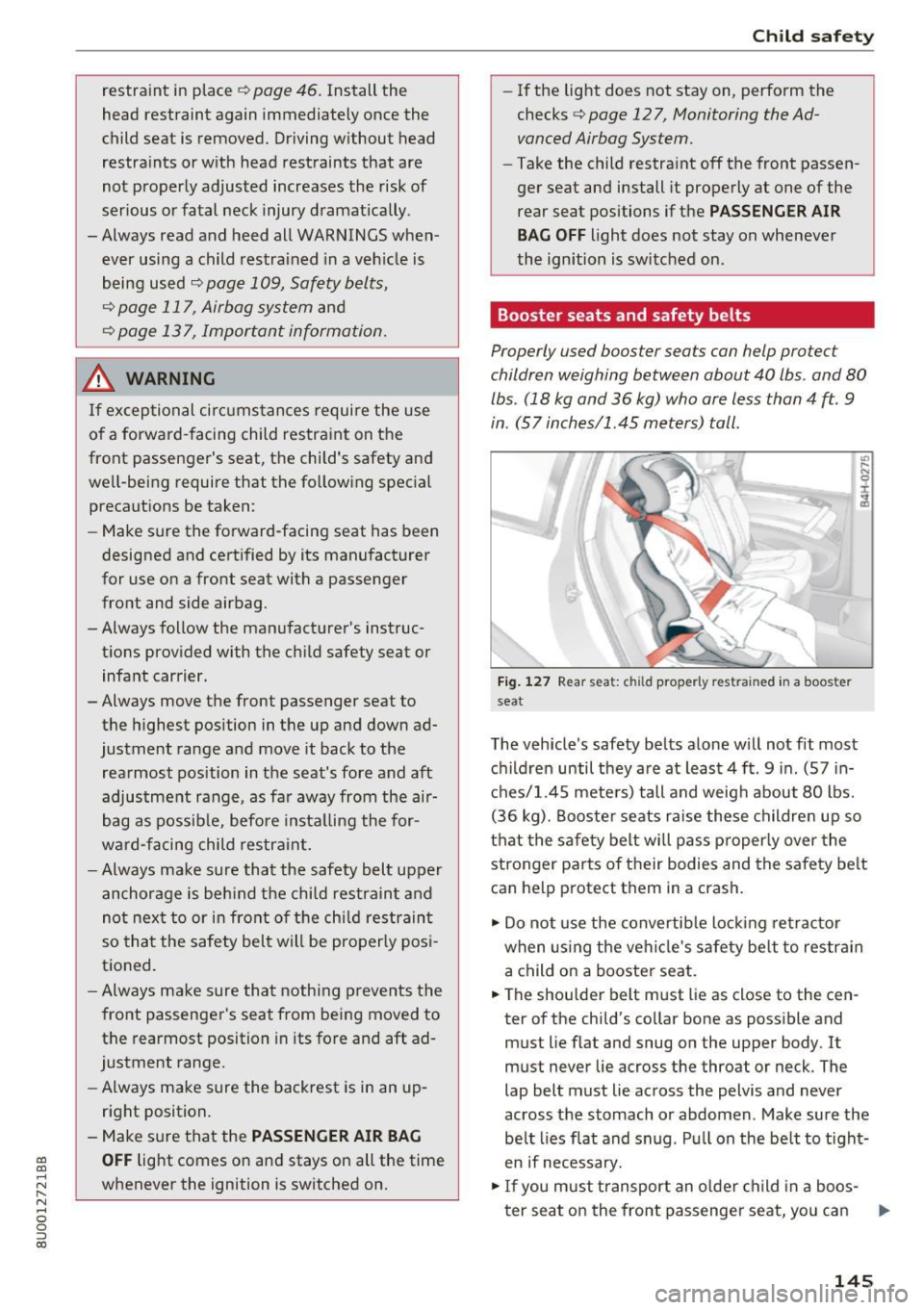
a:,
a:,
...... N r--. N
'"' 0 0 ::, a:,
restraint in place c!;> page 46. Install the
head restraint again immediately once the
child seat is removed. Driving without head
restraints or with head restraints that are
not properly adjusted increases the risk of
serious or fatal neck injury dramatically .
- Always read and heed all WARNINGS when
ever using a child restrained in a vehicle is
being used¢
page 109, Safety belts,
¢ page 117, Airbag system and
¢page 137, Important information.
_& WARNING
If exceptional circumstances require the use
of a forward-facing child restraint on the
front passenger's seat, the child's safety and
well-being require that the following special
precautions be taken:
- Make sure the forward-facing seat has been
designed and certified by its manufacturer
for use on a front seat with a passenger
front and side airbag .
- Always follow the manufacturer's instruc
tions provided with the child safety seat or
infant carrier.
- Always move the front passenger seat to
the highest position in the up and down ad
justment range and move it back to the
rearmost position in the seat's fore and aft
adjustment range, as far away from the air
bag as possible, before installing the for
ward-facing child restraint.
- Always make sure that the safety belt upper
anchorage is behind the child restraint and
not next to or in front of the child restraint
so that the safety belt will be properly posi
tioned.
- Always make sure that nothing prevents the
front passenger's seat from being moved to
the rearmost position in its fore and aft ad
justment range.
- Always make sure the backrest is in an up
right position.
- Make sure that the
PASSENGER AIR BAG
OFF
light comes on and stays on all the time
whenever the ignition is switched on.
Child safety
- If the light does not stay on, perform the
checks¢
page 12 7, Monitoring the Ad
vanced Airbag System.
-T ake the child restraint off the front passen
ger seat and install it properly at one of the rear seat positions if the
PASSENGER AIR
BAG OFF
light does not stay on whenever
the ignition is switched on.
Booster seats and safety belts
Properly used booster seats can help protect
children weighing between about 40 lbs . and 80
lbs . (18 kg and 36 kg) who are less than 4 ~-9
in . (57 inches/1 .45 meters) tall.
Fig. 127 Rear seat: child properly restrained in a boos ter
seat
The vehicle's safety belts alone will not fit most
children until they are at least 4 ft . 9 in . (57 in
ches/1.45 meters) tall and weigh about 80 lbs.
(36 kg). Booster seats raise these children up so
that the safety belt will pass properly over the
stronger parts of their bodies and the safety belt
can help protect them in a crash.
"' Do not use the convertible locking retractor
when using the vehicle's safety belt to restrain
a child on a booster seat.
"'Th e shoulder belt must lie as close to the cen
ter of the child's collar bone as possible and
must lie flat and snug on the upper body. It
must never lie across the throat or neck. The
lap belt must lie across the pelvis and never
across the stomach or abdomen . Make sure the
belt lies flat and snug . Pull on the belt to tight
en if necessary.
"'If you must transport an older child in a boos-
ter seat on the front passenger seat, you can
IIJJ,
145
Page 148 of 236
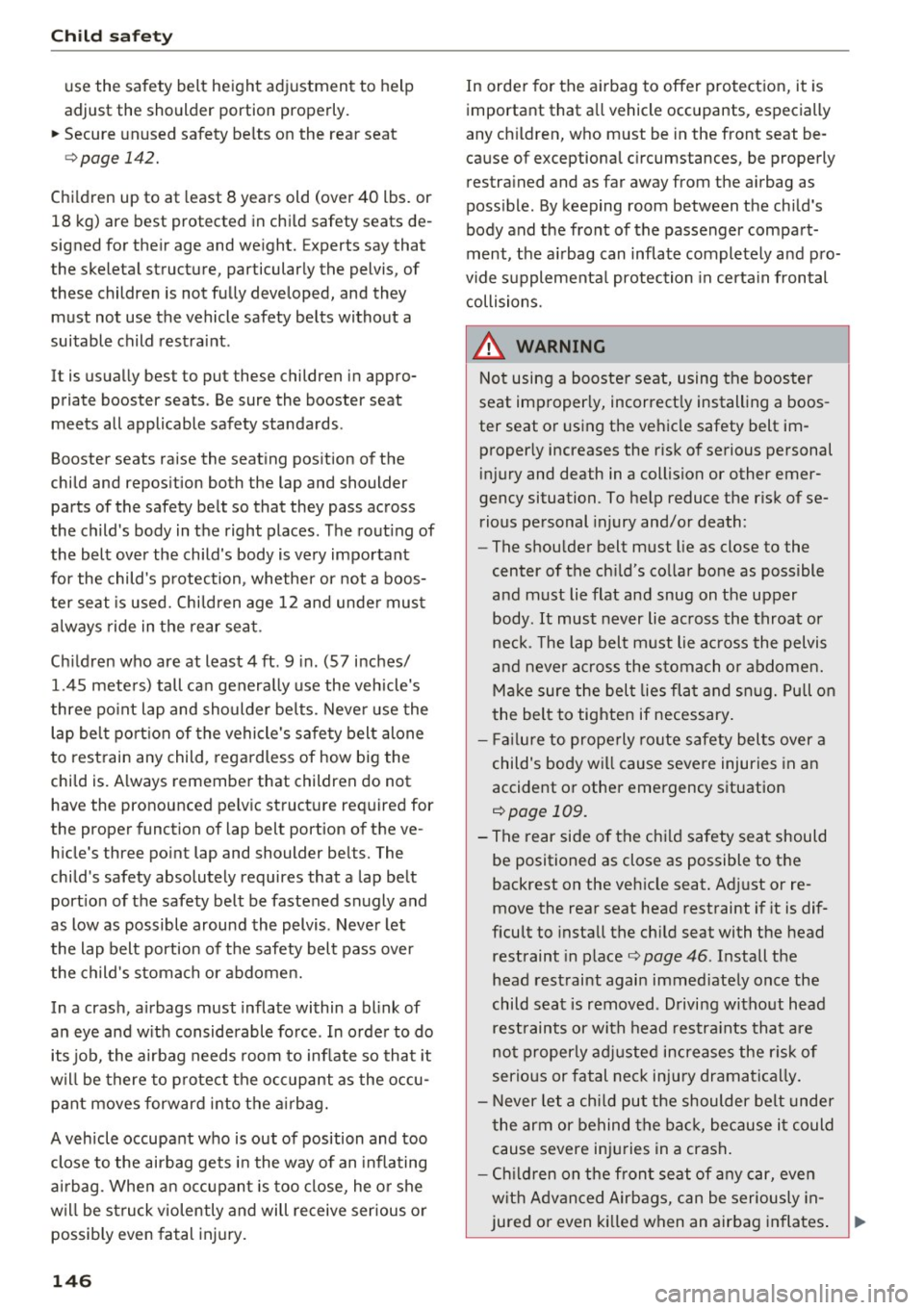
Child safety
use the safety belt height adjustment to help
adjust the shoulder portion properly .
~ Secure unused safety belts on the rear seat
<=>page 142.
Children up to at least 8 years old (over 40 lbs. or
18 kg) are best protected in child safety seats de
signed for their age and weight. Experts say that
the skeletal structure, particularly the pelvis, of
these children is not fully developed, and they
must not use the vehicle safety belts without a
suitable child restraint.
It is usually best to put these children in appro priate booster seats . Be sure the booster seat
meets all applicable safety standards .
Booster seats raise the seating position of the
child and reposition both the lap and shoulder
parts of the safety belt so that they pass across
the child's body in the right places . The routing of
the belt over the child's body is very important
for the child's protection , whether or not a boos
ter seat is used. Children age 12 and under must
always ride in the rear seat .
Children who are at least 4 ft. 9 in. (57 inches/
1.45 meters) tall can generally use the vehicle's
three point lap and shoulder belts. Never use the
lap belt portion of the vehicle's safety belt alone
to restrain any child, regardless of how big the
child is. Always remember that children do not
have the pronounced pelvic structure required for
the proper function of lap belt portion of the ve
hicle 's three point lap and shoulder belts. The
child 's safety absolutely requires that a lap belt
portion of the safety belt be fastened snugly and
as low as possible around the pelvis . Never let
the lap belt portion of the safety belt pass over
the child's stomach or abdomen.
In a crash, airbags must inflate within a blink of
an eye and with considerable force . In order to do
its job, the airbag needs room to inflate so that it
will be there to protect the occupant as the occu
pant moves forward into the airbag.
A vehicle occupant who is out of position and too
close to the airbag gets in the way of an inflating
airbag. When an occupant is too close, he or she
will be struck violently and will receive serious or
possibly even fatal injury.
146
In order for the airbag to offer protection, it is
important that all vehicle occupants , especially
any children, who must be in the front seat be
cause of exceptional circumstances, be properly
restrained and as far away from the airbag as
possible. By keeping room between the child's
body and the front of the passenger compart
ment, the airbag can inflate completely and pro
vide supplemental protection in certain frontal
collisions.
.&_ WARNING
Not using a booster seat, using the booster
seat improperly, incorrectly installing a boos
ter seat or using the vehicle safety belt im
properly increases the risk of serious personal
injury and death in a collision or other emer
gency situation. To help reduce the risk of se rious personal injury and/or death:
- The shoulder belt must lie as close to the
center of the child's collar bone as possible
and must lie flat and snug on the upper
body .
It must never lie across the throat or
neck . The lap belt must lie across the pelvis
and never across the stomach or abdomen.
Make sure the belt lies flat and snug. Pull on
the belt to tighten if necessary.
- Failure to properly route safety belts over a
child's body will cause severe injuries in an
accident or other emergency situation
r=:> page 109.
- The rear side of the child safety seat should
be positioned as close as possible to the
backrest on the vehicle seat. Adjust or re
move the rear seat head restraint if it is dif
ficult to install the child seat with the head
restraint in placer=;,
page 46. Install the
head restraint again immediately once the
child seat is removed . Driving without head
restraints or with head restraints that are
not properly adjusted increases the risk of
serious or fatal neck injury dramatically.
- Never let a child put the shoulder belt under
the arm or behind the back, because it could
cause severe injuries in a crash.
- Children on the front seat of any car, even
with Advanced Airbags, can be seriously in-
-
jured or even killed when an airbag inflates. .,
Page 149 of 236
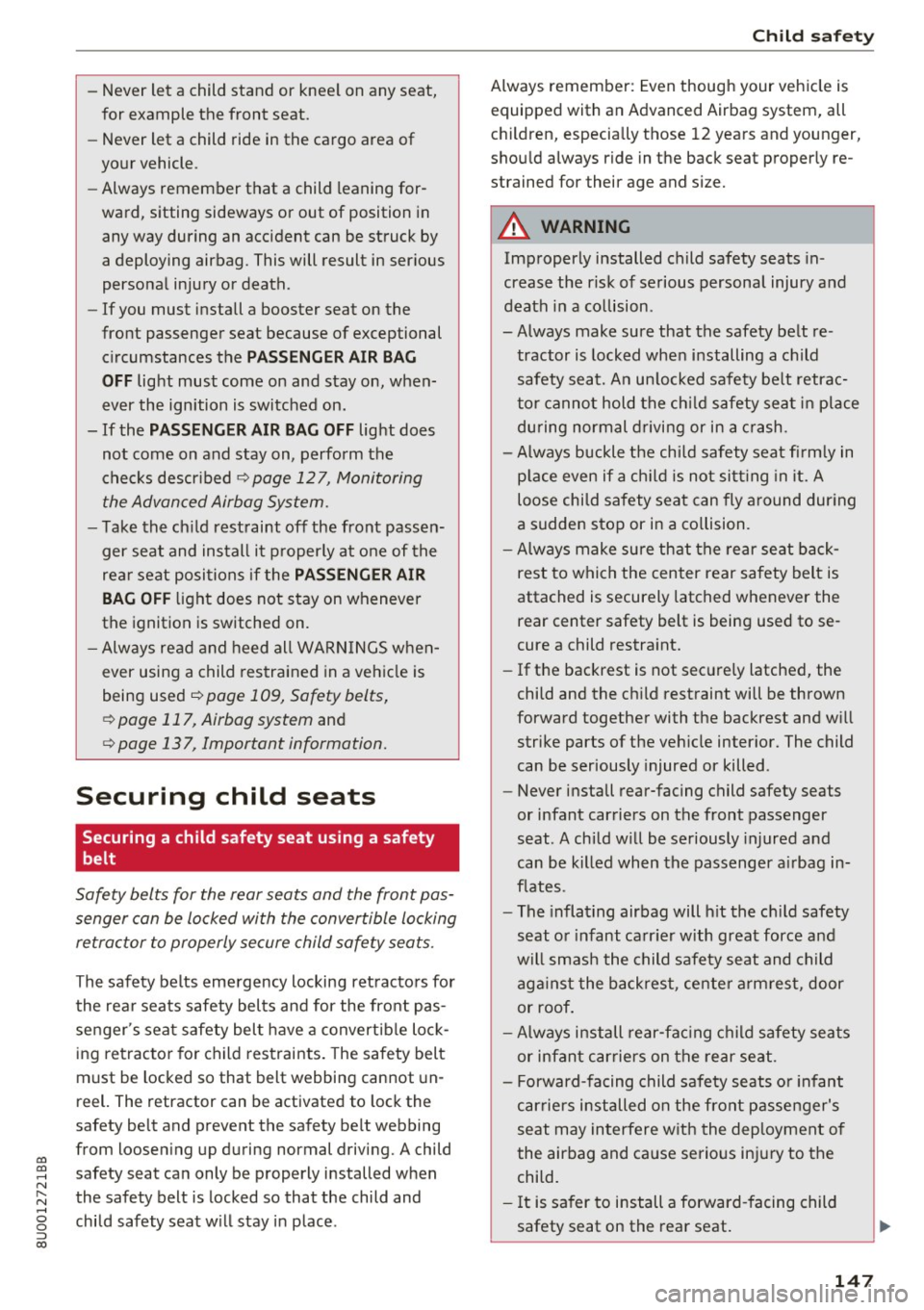
00
00
......
"' ,....
"' ...... 0 0 :::,
00
- Never let a child stand or kneel on any seat,
for example the front seat.
- Never let a child ride in the cargo area of
your vehicle.
- Always remember that a child leaning for
ward, sitting sideways or out of position in
any way during an accident can be struck by
a deploying airbag. This will result in serious
personal injury or death.
- If you must install a booster seat on the
front passenger seat because of exceptional
circumstances the
P A SS ENGER AIR BAG
OFF
light must come on and stay on, when
ever the ignition is switched on.
- If the
PASSENGER A IR BAG OFF light does
not come on and stay on, perform the
checks descr ibed
c:> page 12 7, Monitoring
the Advanced Airbag System.
- Take the ch ild restraint off the front passen
ger seat and install it p roperly at one of the
rear seat positions if the
PA SSENGER A IR
BA G OFF
light does not stay on whenever
the ignition is switched on.
- Always read and heed all WARN INGS when
ever using a child restrained in a vehicle is
being used
r=;, page 109, Safety belts,
c:> page 117, Airbag system
and
c:> page 13 7, Important information.
Securing child seats
Securing a child safety seat using a safety
belt
Safety belts for the rear seats and the front pas
senger can be locked with the convertible locking retractor to properly secure child safety seats .
The safety belts emergency locking retractors for
the rear seats safety belts and for the front pas
senger's seat safety belt have a convertib le lock
ing retractor for child restraints. The safety belt
must be locked so that belt webbing cannot un
reel. The retractor can be activated to lock the
safety belt and prevent the safety belt webbing
from loosening up during normal driving. A child
safety seat can only be properly installed when
the safety belt is locked so that the child and
child safety seat w ill stay in place .
Child safety
Always remember : Even though your vehicle is
equipped with an Advanced Airbag system, all
children, especially those 12 years and younger,
should always ride in the back seat properly re
strained for their age and size.
A WARNING
=
Improperly installed child safety seats in
crease the risk of serious personal injury and
death in a collision .
-
-Always make sure that the safety belt re
tractor is locked when installing a child
safety seat. An un locked safety be lt retrac
tor cannot hold the ch ild safety seat in place
du ring normal driving or in a c rash.
- Always buckle the child safety seat fi rm ly in
p lace even if a ch ild is not sitt ing in it. A
loose child safety seat can fly around during
a sudden stop or in a co llision.
- Always make sure that the rear seat back
rest to which the center rear safety belt is
attached is securely latched whenever the
rear center safety belt is being used to se
cure a child restraint.
- If the backrest is not securely latched, the
child and the child restraint will be thrown
forward together with the backrest and w ill
strike parts of the veh icle inter ior. The child
can be seriously injured or killed .
- Never install rear-facing child safety seats
or infant carriers on the front passenger
seat . A child w ill be seriously injured and
can be killed when the passenger a irbag in
flates.
- The inflating airbag will h it the ch ild safety
seat or infant ca rr ier with great force and
will smash the child safety seat and child aga inst the backrest, cente r armrest, door
or roof .
- Always install rear-fac ing child safety seats
or infant car riers on the rear seat.
- Forward-facing child safety seats o r infant
carriers installed on the front passenger's
seat may interfere with the deployment of
the airbag and cause serio us injury to the
child .
- It is sa fer to install a forward -facing child
safety seat on the rear seat.
147
Page 150 of 236
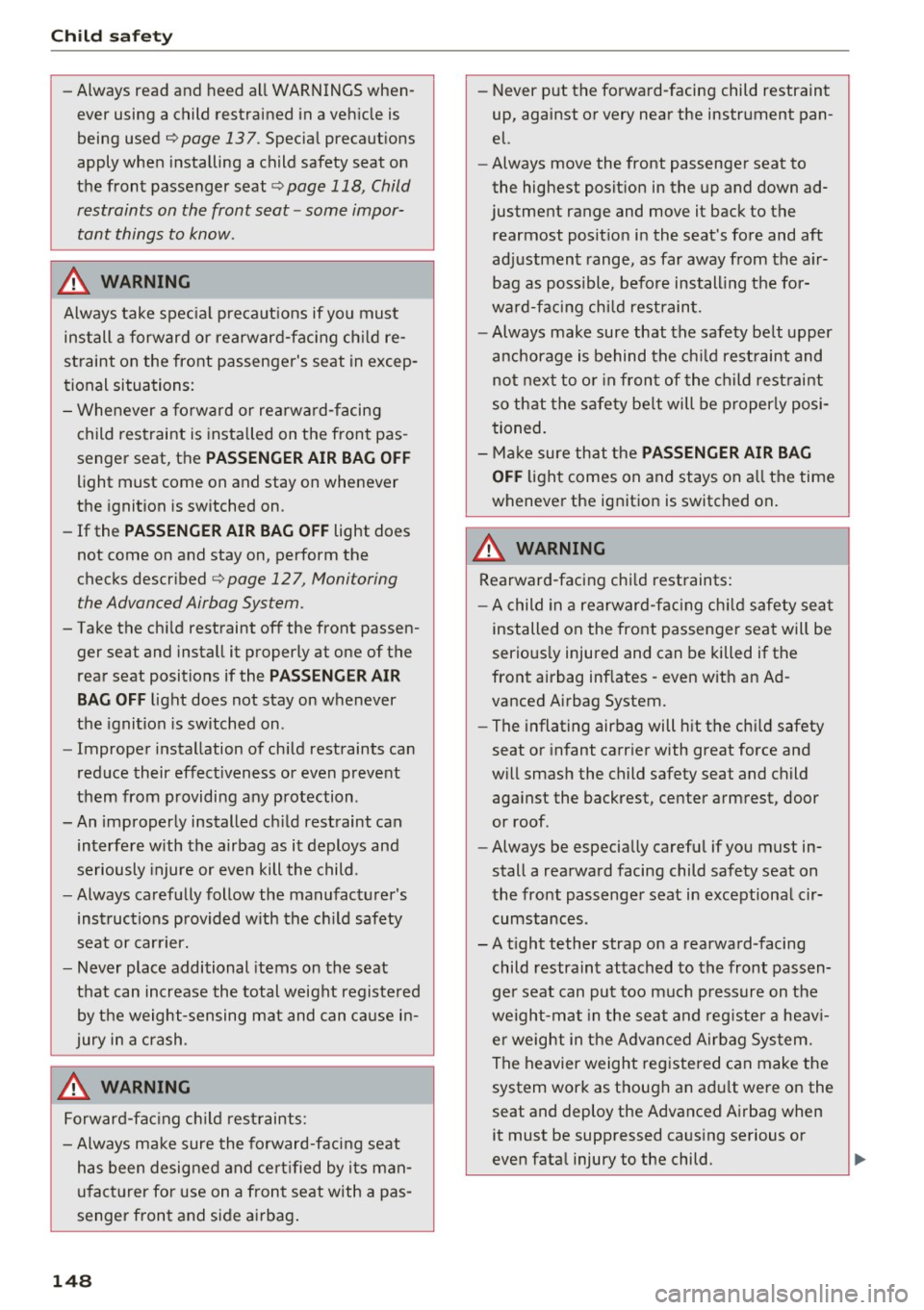
Child safety
-Always read and heed all WARNINGS when
ever using a child restrained in a vehicle is
being used ¢
page 13 7. Special precautions
apply when installing a child safety seat on
the front passenger seat¢
page 118, Child
restraints on the front seat -some impor
tant things to know.
_& WARNING
Always take special precautions if you must
install a forward or rearward-facing child re
straint on the front passenger's seat in excep
tional situations:
- Whenever a forward or rearward-facing
child restraint is installed on the front pas
senger seat, the
PASSENGER AIR BAG OFF
light must come on and stay on whenever
the ignition is switched on.
- If the
PASSENGER AIR BAG OFF light does
not come on and stay on, perform the
checks described
¢ page 127, Monitoring
the Advanced Airbag System.
- Take the child restraint off the front passen
ger seat and install it properly at one of the
rear seat positions if the
PASSENGER AIR
BAG OFF
light does not stay on whenever
the ignition is switched on .
- Improper installation of child restraints can
reduce their effectiveness or even prevent
them from providing any protection .
-An improperly installed child restraint can interfere with the airbag as it deploys and
seriously injure or even kill the child.
-Always carefully follow the manufacturer's
instructions provided with the child safety
seat or carrier.
- Never place additional items on the seat
that can increase the total weight registered by the weight-sensing mat and can cause in
jury in a crash.
_& WARNING
Forward-facing child restraints:
- Always make sure the forward-facing seat
has been designed and certified by its man
ufacturer for use on a front seat with a pas
senger front and side airbag.
148
-
- Never put the forward-facing child restraint
up, against or very near the instrument pan
el.
- Always move the front passenger seat to
the highest position in the up and down ad
justment range and move it back to the rearmost position in the seat's fore and aft
adjustment range, as far away from the air
bag as possible, before installing the for
ward-facing child restraint.
-Always make sure that the safety belt upper
anchorage is behind the child restraint and
not next to or in front of the child restraint
so that the safety belt will be properly posi
tioned.
- Make sure that the
PASSENGER AIR BAG
OFF
light comes on and stays on all the time
whenever the ignition is switched on.
_& WARNING
Rearward-facing child restraints:
-A child in a rearward-facing child safety seat
installed on the front passenger seat will be
seriously injured and can be killed if the
front airbag inflates -even with an Ad
vanced Airbag System.
- The inflating airbag will hit the child safety
seat or infant carrier with great force and
will smash the child safety seat and child
against the backrest, center armrest, door
or roof.
- Always be especially careful if you must in
stall a rearward facing child safety seat on
the front passenger seat in exceptional cir
cumstances .
- A tight tether strap on a rearward-facing child restraint attached to the front passen
ger seat can put too much pressure on the
weight-mat in the seat and register a heavi
er weight in the Advanced Airbag System.
The heavier weight registered can make the
system work as though an adult were on the
seat and deploy the Advanced Airbag when
it must be suppressed causing serious or
even fatal injury to the child.